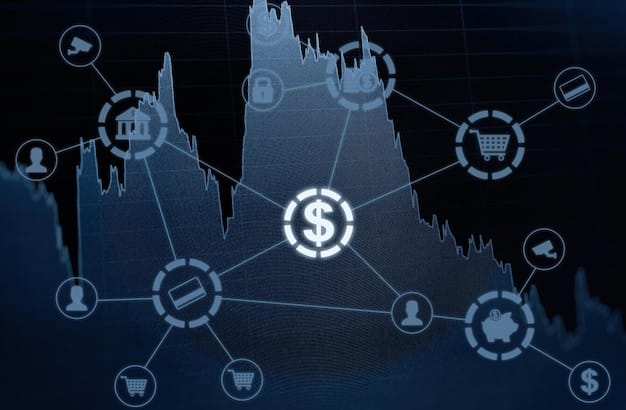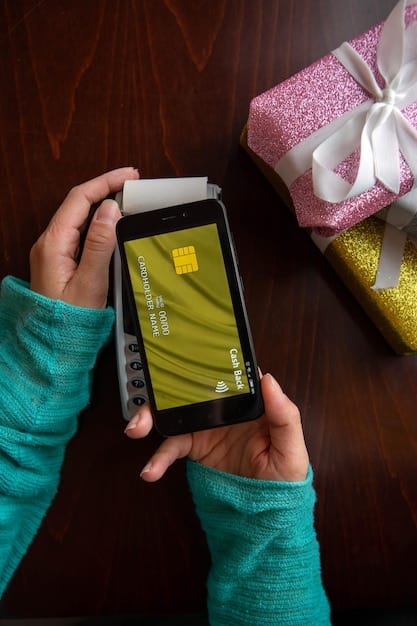Maximize Customer Loyalty: Digital Payment Rewards Programs for US Businesses

Maximizing customer loyalty with digital payment rewards programs involves strategically designing and implementing incentives that encourage repeat business and foster stronger relationships between US businesses and their customers through the convenience and efficiency of digital payment methods.
In today’s competitive market, retaining customers is just as crucial as acquiring new ones, and one increasingly effective strategy is maximizing customer loyalty with digital payment rewards programs. These programs offer a seamless way for US businesses to incentivize customers and foster long-term relationships, all while leveraging the convenience and efficiency of digital payments.
Understanding the Power of Digital Payment Rewards Programs
Digital payment rewards programs are revolutionizing how US businesses connect with their customers. By offering incentives for using digital payment methods, companies can encourage repeat purchases and cultivate brand loyalty. These programs provide a win-win scenario: convenience and rewards for customers, and increased customer retention for businesses.
The shift towards digital payments has created a unique opportunity for businesses to tap into the power of rewards programs. Let’s delve deeper into why these programs are so effective and how they can be tailored to suit different business needs.
Why Digital Rewards Programs Matter
Digital rewards programs extend beyond simple discounts; they represent a strategic approach to enhancing customer engagement and lifetime value. They also provide valuable data insights into customer behavior, enabling businesses to refine their offerings and marketing strategies.
The Evolution of Loyalty Programs
Traditional loyalty programs often rely on physical cards or cumbersome processes. Digital programs, however, leverage technology to offer a more streamlined and engaging experience. This evolution has made it easier for both businesses and customers to participate and benefit from loyalty initiatives.
- Improved Customer Experience: Digital rewards create a smoother, more convenient interaction for customers.
- Data-Driven Insights: Businesses gain valuable insights into customer behaviour and preferences.
- Increased Customer Retention: Effective programs ensure customers remain engaged and loyal.
- Competitive Advantage: A well-designed program can differentiate a business from its competitors.

In conclusion, understanding the power of digital payment rewards programs is crucial for any US business looking to enhance customer loyalty. By embracing technology and creating tailored incentives, companies can forge stronger relationships and drive sustainable growth.
Designing Effective Rewards Programs for US Customers
Designing an effective rewards program requires a deep understanding of your target audience and their preferences. US customers are diverse, and a one-size-fits-all approach is unlikely to succeed. Factors like demographics, purchasing habits, and technological adoption should all be considered.
The key is to create a program that is both attractive and easy to use. Let’s examine the critical elements of designing a program that resonates with US customers and drives measurable results.
Understanding Your Target Audience
Before launching a program, conduct thorough market research to understand your customers’ needs and desires. What kind of rewards would they value most? What are their preferred communication channels? Answering these questions will help you create a program that is truly tailored to their interests.
Choosing the Right Rewards
The rewards you offer should be relevant to your brand and appealing to your target audience. Common options include discounts, exclusive access, bonus points, and personalized offers. Consider tiering your rewards to incentivize higher levels of engagement.
Creating a successful rewards program involves choosing rewards that resonate with your customers and align with your business objectives. Here are some popular options:
- Discounts and Coupons: Providing instant savings on purchases.
- Exclusive Access: Offering early access to sales or new products.
- Points Systems: Earning points for every dollar spent, which can be redeemed for rewards.
- Personalized Offers: Tailoring rewards based on individual customer preferences.
Ultimately, the success of a digital payment rewards program hinges on creating a meaningful value proposition for your customers. Regularly evaluate program performance and make adjustments as needed to ensure continued engagement.
Integrating Digital Payments for Seamless Rewards
The integration of digital payments is foundational for any successful rewards program. US consumers increasingly prefer the convenience of mobile wallets, online transactions, and contactless payments. By embracing these technologies, businesses can offer a seamless and frictionless experience.
A well-integrated system not only simplifies the payment process, but also allows for automatic rewards tracking and redemption. Let’s explore how you can effectively integrate digital payments into your rewards program.

Selecting the Right Payment Platform
Choosing a payment platform that supports rewards integration is crucial. Look for options that offer APIs and developer tools to seamlessly connect your rewards program with your payment processing system. Popular platforms include Stripe, PayPal, and Square.
Ensuring a Smooth User Experience
The payment process should be as simple and intuitive as possible. Customers should be able to easily redeem rewards during checkout with just a few clicks or taps. Clear and concise instructions can help minimize any confusion.
Integrating digital payments ensures that customers enjoy a hassle-free rewards experience. Here are key considerations:
- Mobile Wallet Compatibility: Enable customers to use popular mobile wallets like Apple Pay and Google Pay.
- One-Click Redemption: Simplify the rewards redemption process at checkout.
- Real-Time Tracking: Provide customers with immediate visibility into their rewards balances.
Properly integrating digital payments into your rewards program can significantly enhance customer satisfaction and drive program participation. By focusing on convenience and ease of use, you can create a system that is both rewarding for your customers and beneficial for your business.
Promoting Your Digital Payment Rewards Program
An excellent rewards program is only effective if your customers know about it. Promoting your program is essential for driving awareness and encouraging participation. Utilize a multi-channel approach to reach your target audience through various touchpoints.
Here are some key strategies for effectively promoting your digital payment rewards program to US customers.
Leveraging Social Media
Social media provides a powerful platform for sharing your rewards program with a broad audience. Create engaging content that highlights the benefits of the program and encourages sign-ups. Consider running targeted ads to reach specific customer segments.
Email Marketing Campaigns
Email marketing is an effective way to communicate directly with your customers. Send out regular newsletters with updates on rewards, special promotions, and program news. Segment your email lists to personalize your messages and increase engagement.
To maximize participation, businesses should actively promote their digital payment rewards programs. Here are some best practices:
- Social Media Engagement: Utilize platforms like Facebook, Instagram, and Twitter to promote your program.
- Email Marketing: Send personalized emails highlighting rewards and promotions.
- In-Store Promotions: Display signage and train staff to inform customers about the program.
- Website and App Integration: Prominently feature the rewards program on your website and mobile app.
By strategically promoting your digital payment rewards program, you can attract new customers, retain existing ones, and drive significant growth for your business.
Measuring and Optimizing Program Performance
Once your digital payment rewards program is up and running, it’s crucial to track its performance and make adjustments as needed. Monitor key metrics to gauge its effectiveness and identify areas for improvement. Data-driven insights will help you optimize your program for maximum impact.
Here’s a guide to measuring and optimizing your digital payment rewards program.
Tracking Key Metrics
Monitor metrics such as customer enrollment rates, redemption rates, customer retention, and average purchase value. These metrics will provide valuable insights into customer engagement and the overall success of your program.
Gathering Customer Feedback
Solicit feedback from your customers through surveys, feedback forms, and social media channels. Understanding their experiences and suggestions will help you fine-tune your program to better meet their needs and expectations.
Optimizing your digital payment rewards program involves continuous monitoring and adjustment based on data and customer feedback:
- Analyze Redemption Rates: Understand which rewards are most popular and effective.
- Monitor Customer Retention: Track the impact of the program on customer loyalty.
- Gather Customer Feedback: Use surveys and feedback forms to identify areas for improvement.
- A/B Testing: Experiment with different rewards and program structures to optimize performance.
By tracking, analyzing, and optimizing your digital payment rewards program, you can ensure it remains effective in driving customer loyalty and achieving your business goals. Regularly review and adapt your program to stay ahead of the curve and meet the evolving needs of your customers.
Case Studies: Successful Digital Payment Rewards Programs in the US
Examining real-world examples of successful digital payment rewards programs can provide valuable insights and inspiration. Several US businesses have effectively leveraged digital payments to enhance customer loyalty and drive business growth.
Let’s take a look at some notable case studies:
Starbucks Rewards
The Starbucks Rewards program is a prime example of a successful digital loyalty initiative. Customers earn stars for every purchase made through the Starbucks app, which can be redeemed for free drinks and food. The program’s ease of use and compelling rewards have contributed to its widespread popularity.
Amazon Prime Rewards Visa Signature Card
The Amazon Prime Rewards Visa Signature Card offers cardholders 5% back on all purchases made on Amazon and at Whole Foods Market. This program seamlessly integrates digital payments with rewards, making it a highly attractive option for Amazon Prime members.
Here is a brief review of some other successful digital payment rewards programs in the US:
- Target Circle: Offering personalized deals and rewards to Target shoppers.
- Chase Ultimate Rewards: Providing flexible redemption options and bonus points for cardholders.
- Sephora Beauty Insider: Rewarding customers with points for every purchase, which can be redeemed for beauty products and experiences.
These case studies demonstrate the power of digital payment rewards programs in driving customer loyalty and business growth. By studying these successes and adapting their strategies, businesses in the US can create impactful programs that resonate with their target audiences.
| Key Aspect | Brief Description |
|---|---|
| 💰 Rewards Design | Tailoring rewards to match customer preferences. |
| 📱 Digital Integration | Seamlessly integrating digital payments and rewards. |
| 📢 Promotion | Effective marketing to drive program awareness. |
| 📈 Measurement | Tracking performance for program optimization. |
Frequently Asked Questions
▼
Digital payment rewards programs are loyalty initiatives that incentivize customers to use digital payment methods. These programs offer rewards such as discounts, exclusive access, or points for purchases made using digital payment methods.
▼
These programs enhance customer loyalty, increase repeat purchases, and provide valuable data insights. In the competitive US market, they can also differentiate a business and attract new customers.
▼
Start by understanding your target audience, choose relevant rewards, and integrate digital payments seamlessly. Promote your program effectively and track performance to optimize for maximum impact.
▼
Key metrics include customer enrollment rates, redemption rates, customer retention, and average purchase value. Soliciting customer feedback is also important for identifying areas for improvement.
▼
The key is to create a program that offers real value to your customers, makes participation easy, and provides a seamless user experience. Continuous monitoring and adjustment are essential for long-term success.
Conclusion
Maximizing customer loyalty with digital payment rewards programs is a strategic imperative for US businesses in today’s digital age. By designing effective programs, integrating digital payments seamlessly, and continuously optimizing based on data and customer feedback, businesses can forge stronger customer relationships, drive growth, and thrive in a competitive market. Embracing these strategies not only benefits businesses but also enhances the overall customer experience, creating a win-win scenario for all stakeholders.





